I’ve long wanted to cycle the Dunstan Trail in Central Otago with its novel “clip on” sections, bolted to the rock. In fact, I’ve previously cycled part of it from Smith’s Way (the start of the Dunstan Trail) to the Bannockburn Bridge. Thus far, it was just grade two.

I did it!
However, I have not ridden past the terrifying danger signs at Cornish Point, warning riders of the steep drop offs and narrowing sections. Here, the track morphs to grade three. Apparently, riding competence and skill are required, and I wasn’t sure I had it.
However, I’ve finally done it and cycled not only the Dunstan Trail, but also the Clutha Gold Trail and Roxburgh Gorge. I feel very pleased with myself.
If you are confident on an e-bike, give it a go, as its absolutely stunning. When in doubt, walk if you feel out of your comfort zone.
A word of warning, the track can be ridden in both directions, from Queenstown, to Clyde and via versa. So to avoid the crowds, and oncoming traffic on the narrower sections of the trail, avoid weekends and the peak summer season.
Good weather, with no rain or gales will also add to your enjoyment.
But before I get carried away with the creme de la crème of this bike ride, the Dunstan Trail, let me tell you a little more about our five day bike ride, of which the Dunstan Trail was just a part.
Day one – Queenstown to the historic Kawerau Bridge – 40km
We started in Queenstown and meet our two delightful guides from Adventure South, Anouk and Harry. We introduced ourselves to our fellow riders and set off on the first stretch of the trail.

The biking crew.
The way the trip works in one guide drives the mini-van, while the other guide cycled with us. There is great support and flexibility for riders. For example, if a rider chooses not to cycle a stretch of the trail, their bike can be loaded on the trailer.
The 40km cycle took us from Queenstown along the beautiful shores of Lake Wakatipu to the Old Shotover Bridge. From here we joined the Twin River trail to the historic town of Arrowtown, famous for its goldmining in the 1860s. Some of the old miner huts still exist and are well worth visiting.

The historic town of Arrowtown.
We had lunch in the very quaint town and wondered around, before we got back on our bikes cycling the Arrow River Trail. This is one of my favourite walks, with our West Highland Terrier, Millie, when we are in Arrowtown. She loves to swim in the river.

Millie, my Westie enjoying a swim in the Arrow River.
We rode through the Gibbston Valley, well known for its wines and Central Otago Pinots, before finished our cycle at the historic, Kawerau Bridge. It is famous for its bungy platform. We watched the fearless young, throw themselves off the platform, with little regard for their bodies, while we contemplated our eyeballs popping out, or the need for a defibrillator.

The bungy at the historic Kawerau Bridge.
From the bungy bridge, we bused to Wanaka, as the trail from the Kawerau Bridge to Cromwell is still under construction. The Kawerau Gorge Trial, when completed will be 32km, bridging the gap between Queenstown, through the Nevis Bluff, and the other popular Central Otago trails.
Once in Wanaka, we got to know our fellow cyclists over dinner at the Speights Ale House. I was in awe of the capabilities of many of our co-riders, including Pete from Hastings. He claims to be an octogenarian, but certainly didn’t look like one. We also had a group from South Australia, all good friends from a walking group, who had included this cycling trip in the three week New Zealand holiday. Dave, Jeff and Mary, and my mates Deb and Jenni, made up the fabulous group of 12.

The Wanaka tree.
Accommodation : The Edgewater Resort, Wanaka
Dinner: Speights Ale House
Day 2 – Wanaka to Lake Hawera, plus the first half of the Dunstan Trail – 41km
The next morning we set off cycling around Lake Wanaka, followed the Clutha River outlet. The Clutha River is New Zealand’s second largest river. It starts at Lake Wanaka and eventually enters the Pacific Ocean near Balclutha, south of Dunedin. It is the Clutha, River, we followed for nearly the whole biking trip.

Lake Wanaka and the Clutha River outlet.
We stopped in Albert Town for morning tea at the Pembroke Patisserie. The pastries and pies were outstanding. With more unnecessary fuel on board, we rode to Lake Hawera, lakeside for lunch. Looking down the lake, framed by mountains, is an incredible view.

Lunching lakeside at Lake Hawera.
After lunch we travelled for a short distance in the van to the official beginning of the Dunstan Trail, Smith’s Way. The ride was easy, cycling alongside Lake Dunstan. We passed the Pisa Moorings, a number of small inlets, with homes lake side. Our day was complete as we rode into Cromwell’s historic town, before finding our accommodations for the night.

Riding around Pisa Moorings on route to Cromwell.

Cromwell Historic Precinct.
The historic town of Cromwell was flooded when the Clyde Dam was completed in 1992, creating Lake Dunstan. As a result, many of historic buildings from the gold rush days in the 1860s, were disassembled, and have since been rebuilt on higher ground. The pedestrianized area, is known as the Cromwell Heritage Precinct.
Accommodation : Carrick Lodge Motel, Cromwell
Dinner : Thai Crom Restaurant
Day 3 – Second half of the Dunstan Trail – 53km
Today, we rode the second half of the Dunstan Trail, the challenging part, from Cromwell to the Clyde Dam.
I was a little nervous, hoping the ride would go well with no injuries. The great thing about having guides, is they have observed our riding ability over the last few days, and tell us, it’s well within our capabilities.
The ride from Cromwell to the Bannockburn Bridge was stunning and very scenic with the delicious autumn colours.

Riding around the Bannockburn inlet, the autumn colours were outstanding.

Then we rode through Carrick’s vineyards, with most of the grapes covered with netting, ready for harvest
Then, from Cornish Point things got a little tougher. There are two quite steep ascents and descents, but very do able in ‘boost’ mode (top gear) on our e-bikes. The switchbacks were easier than I had anticipated, as were the several narrow sections. The ‘clip on’ parts of the trail were dramatic. Being cantilevered over the mighty Clutha River was quite surreal. We’re lucky significant investment has been made to these South Island trails, enabling us to experience what would otherwise be inaccessible parts of the country.

The cantilevered section of the Dunstan Trail are very picturesque.

The coolest coffee shop on the trail.

Great engineering, makes the trail possible.

High up on the trail the terrain was raw, creating some stunning scenery.

As the Clyde dam came into view I felt exhilarated. It’s a giant hydro dam with Lake Dunstan on one side and the Clutha River on the other. Clyde grew up from the former settlement of Dunstan, during the gold rush in the 1860s. The name change came about in 1865, when the town’s post office was offically renamed Clyde, after Lord Clyde.
Having passed the dam we continued cycling into the historic town of Clyde, much like the historic Cromwell precinct, with its old buildings from the gold rush era.


Accommodation : Dunstan House, Clyde
Dinner: Post Office Café and Bar
Day 4 – Clutha Gorge from Lawrence to Roxburgh – 58km
Over the next two days we cycled the Clutha Gold Trail and Roxburgh Gorge to complete the five day bike ride.
We drove to Lawrence to start our ride, the birthplace of the 1860s gold rush. In its heyday, Lawrence was one of New Zealand’s largest communities with a population double the size of Dunedin.
We biked through the Big Tunnel, 434 metres in the dark, then continued onto Beaumont, where we cycled 20km along the scenic Clutha River. We continued on through Miller Flat to Roxburgh where we spent our last night.

The Clutha River.

Accommodation : Roxburgh Lodge, Roxburgh
Dinner : Roxburgh Lodge
Day 5 – Roxburgh to Queenstown, via the Clutha Gold and Roxburgh Gorge Trails – 37km
On our final day of the bike ride we rode from just outside of Roxburgh to the Roxburgh Dam. It’s the second dam on the Clutha River, after the Clyde Dam. The Roxburgh Dam marks the end of the Clutha Gold Trail and the beginning of the Roxburgh Gorge Trail. The remote ride was exhilarating, however halfway through the trail, the track ended. Some land owners allow the use of their land for the Roxburgh Gorge Trail, however, this land owner has prohibited the use of his land. So we were met by the Clutha River Cruises, who loaded our bikes onto the jet boat and took us on a scenic, history trip, 10km down the river, to meet up with the next section of the trail.

The Roxburgh Dam.

Jet boating down the Clutha River to the next section of the trail.
We saw multiple remnants of the gold miners homes from the 1860s. They lived harsh and miserable lives, with huts dug out of the schist alongside the river. The temperatures were freezing in the winters. They got their mining concessions from the Government and worked tirelessly trying to make their fortunes.

Remnants of the gold miners homes.
The second half of the Roxburgh Gorge was as remote as the first and we eventually emerged in Alexandra, marking the end of our riding adventure. Like our other bike trip in New Zealand, we had experiemced parts of the country, inaccessible prior to the creation of these magnificent trails.

The Clutha River meandering through Alexandra

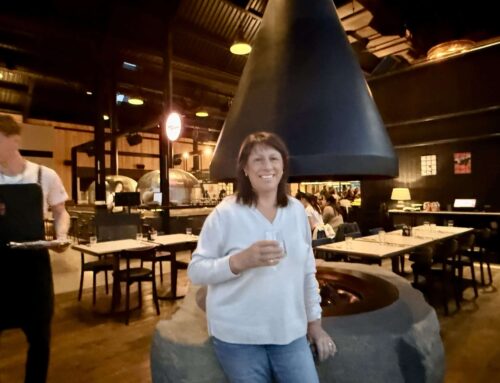
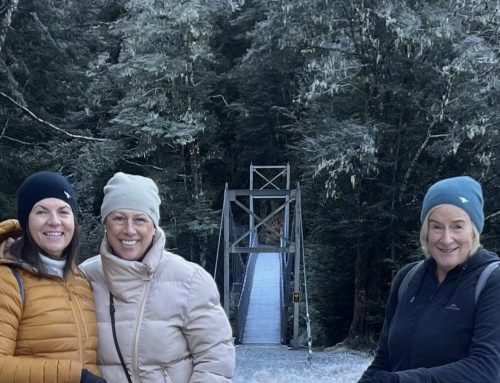
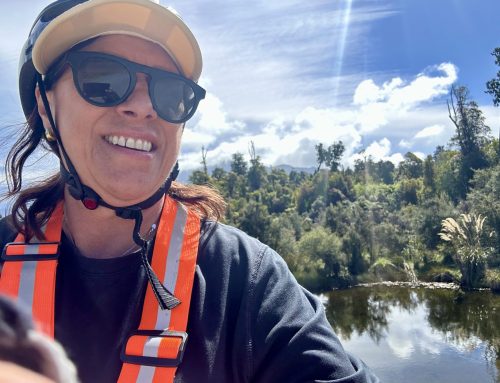
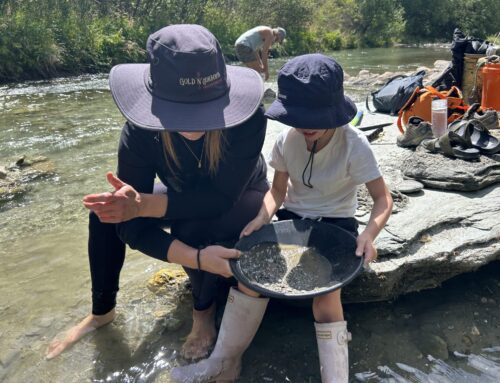
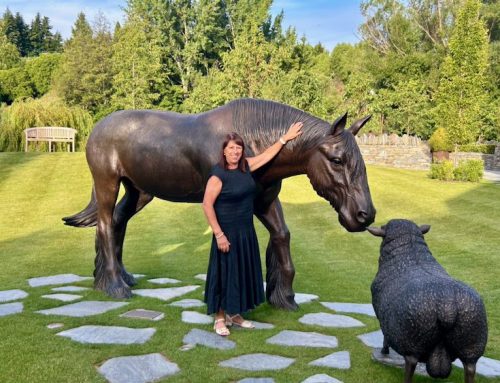
Leave A Comment